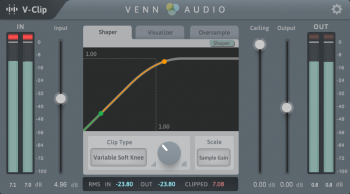Venn Audio V-Clip v1.0.02 X64 WiN AAX VST VST3 FiX

WiN | AudioZ Exclusive | 7.06 MB
V-Clip is here! Finesse your distortion with multiple waveform displays, fine-grain controls over positive/negative samples, DC offset and clipping function parameters. V-Clip is equally well suited as a creative saturation tool as it is as a mastering stage professional clipping maximizer.
Features include:
* Live tracing of your signal along the clipping curve for clear and transparent monitoring of your signal loudness and clipping amount.
* Double-precision 64-bit floating-point processing supported natively and upscaled internally regardless of input.
Large selection of different clipping sigmoid functions to choose from.
* Up to 256x oversampling with three different advanced polyphasic anti aliasing filter types.
* Custom clipping mode to provide separate waveshaping for positive and negative samples plus DC offset control and filtering, allowing for unique sounding distortion with even and odd harmonics.
* Advanced waveform visualisation and oscilloscope view.
* Use Auto-gain or auto-ceiling to adjust for new peaks introduced by oversampling, or inter-sample peaks
* Built in test-tone, gain matching.
This release has been exclusively provided to AudioZ by our anonymous reverse engineer.
